A two day Private Tour in North Norfolk. Wednesday was very cloudy and grey but dry, with a cool northerly wind which was not as strong as forecast. Thursday was mostly cloudy and grey too, but the wind had dropped further and we had a couple of very brief glimpses of what appeared to be the sun – a very rare sight in the UK this summer!
Wednesday 1st September
With a request to try some seawatching if possible, we headed first to Sheringham this morning. Conditions are all important for seawatching and there was forecast to be a moderate to blustery north wind again today. However, as we drove down, we noticed that the trees were not moving as much as we would have expected. When we got to Sheringham our fears were confirmed and the wind had indeed fallen lighter than forecast.
We decided to have a go anyway, as there has been some significant movements of waders and wildfowl this week which are not so dependent on conditions. There were still a few ducks moving – little groups of Teal, several parties of Common Scoter, and a few Wigeon with them. One Redshank flying west was the only wader this morning.
There were still Gannets passing by and others feeding offshore, plus some distant Kittiwakes and one or two Sandwich Terns closer in. A Great Skua came up briefly up off the sea, probably waiting to attack one of the terns if it could spy one with a fish. Two more flew west along the horizon but were very distant and very hard to see. A Red-throated Diver flying west was easier to see and a Guillemot flew past.
We gave it an hour but it didn’t look like we would get much more of interest this morning, so we opted to move on and drove further east to Cromer. There were not many gulls on the beach or around the pier at first – a few hanging in the air over the east end of the prom, and lots more out chasing behind a distant crab boat. There was a surf school on the beach this morning, so lots of disturbance on the sand.
We stopped on the far side of the pier to scan. A Fulmar flew past offshore and there were still some Common Scoter passing. Then we spotted our target – a juvenile Caspian Gull flying round the end of the pier, but unfortunately it went round behind the lifeboat house and was lost to view. A dark juvenile Lesser Black-backed Gull was more accommodating.
As we waited to see if the Caspian Gull would reappear, more large gulls started to drift in from the sea and land on the beach. On cue either the same or another Caspian Gull flew in and landed with them. We had just got the scopes on it, when it was flushed by one of the surfers, and the gulls all scattered. Most seemed to fly off east.
Change of plan, we went to get some bread from the nearby shops to see if we could tempt one in. When we got back, we noticed a few gulls on the booking office at near end of the pier so we walked back to get an angle to have a quick look through them before any food would cause chaos. Lucky we did, as there was a juvenile Caspian Gull standing on the roof.

We had a really good look at the Caspian Gull through the scopes now. It was wearing a red colour-ring with the code ‘F.E’ – a quick check with one of the local birders confirmed it was a Dutch bird, ringed in the colony where it was born, in May this year. We could see its strikingly pale head, particularly compared to the nearby juvenile Herring Gulls, and dark shawl, long pointed face and long parallel-sided bill.
Mission accomplished here, we moved on again. There had been a Red-breasted Flycatcher at Trimingham yesterday afternoon, but a message came through to say there was no sign of it this morning. So we made our way back to to Beeston Bump to see if we could find any migrants ourselves. We were just walking down the track towards the railway line, when something flicked across in front of us. It landed on the edge of the hedge the other side. A Pied Flycatcher! It flicked back across the track and perched up nicely for a couple of seconds, then flew to the other side again and was lost to view. As we walked slowly up to where it had been we couldn’t find it again now.
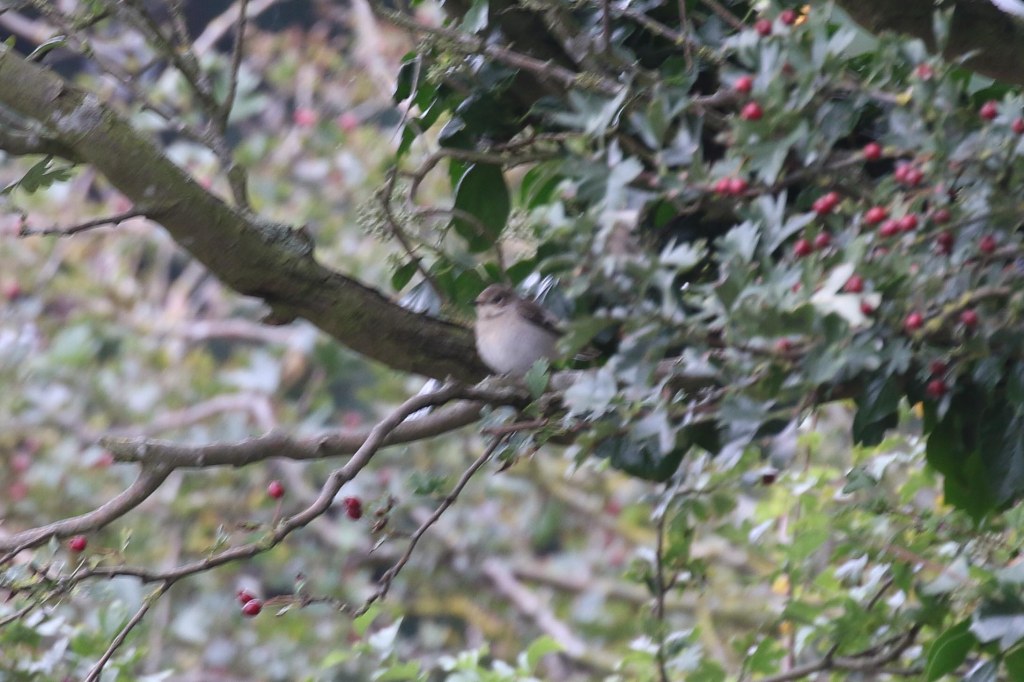
Emboldened by our Pied Flycatcher, we continued on across the railway line and explored the bushes in the hope of finding more migrants. There were several Linnets and Goldfinches and a couple of Chiffchaffs calling from the shelter of the bushes, but no other obvious migrants. Perhaps it was a bit too cool and breezy so close to the clifftop, which is why the Pied Flycatcher had moved to the more sheltered lane? A rather tatty Common Blue butterfly was a bit of a surprise, given the cool weather.
As we made our way back to the minibus, a large Hoverfly Volucella inanis, one of the big hornet or wasp mimics, was trying to warm up on a branch by the track. It was time for lunch now, so we drove up to the picnic area at Pretty Corner where we were out of the wind. After lunch, we made our way west towards Wells and stopped at the pools just before town.
As we parked and got out of the bus, we heard Whimbrel calling and looked up to see two flying high west. We scanned the pools from the car park first. The pool to the west of the track is now dry, but there is still lots of water to the east. A single Ringed Plover flew round with a Dunlin and they both landed on the mud at the front. Another small group of Dunlin was feeding slightly further behind.
Four small waders flew up from somewhere at the back of the pools and we watched them as they flew across. As they got closer, we could see they were four Little Stints. They continued on over the track, and we watched as they disappeared off west, round the front of Wells. There were several Common Snipe feeding round the muddy edges of the pool and lots of Black-tailed Godwit and Ruff further back.
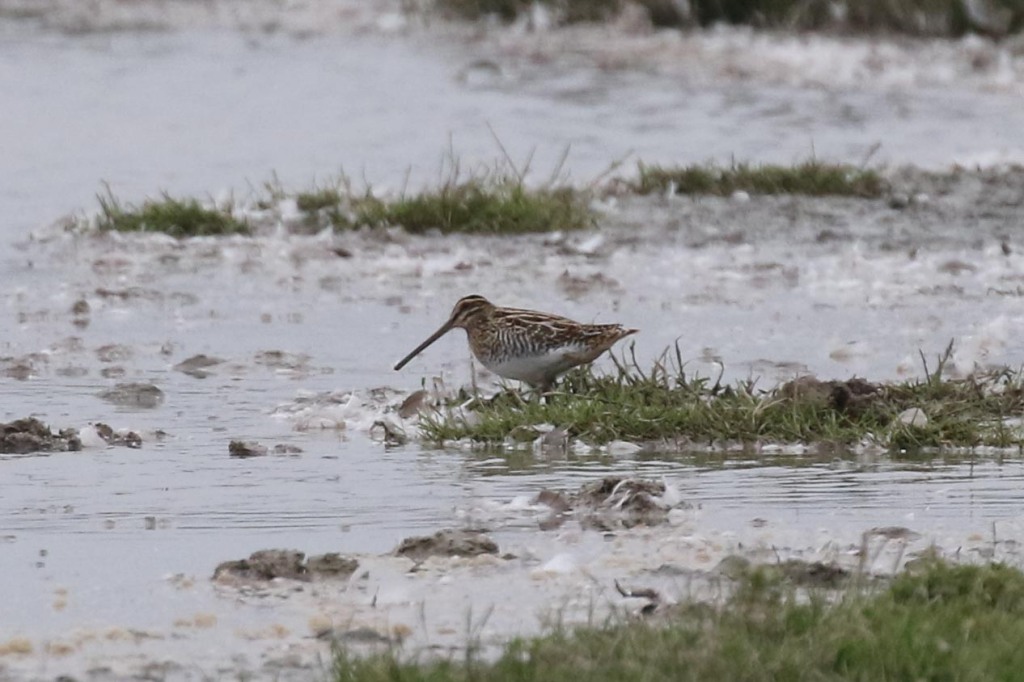
We could see a good number of Wigeon in the grass around the pool, with increasing numbers now returning for the winter, as we saw earlier this morning. Through the scopes, we picked out a few Gadwall and Shoveler at back. The other side of the track, there were lots of geese loafing around the dry pools, mainly Greylags but with several Egyptian Geese too.
There were lots of distant hirundines over the edge of Wells and we were just looking through them to see if we could find a late Swift when a Hobby appeared. It shot through them and then disappeared off inland. We could see it circling away in the distance. Several Common Buzzards kept coming up from the pig fields just inland and a Marsh Harrier was hunting briefly over the fields beyond the pools.
We walked on down the track for closer views of some of the waders. As we scanned, we picked up the Hobby again, way off to the east now, harrassing another flock of Swallows over the trees in the distance.
As we were scanning the far corner of the pool from the end of the track, we picked up a Common Sandpiper flying towards us over the water. It flew straight over our heads, and dropped down the other side of the track. There is still lots of water in the foot drain, so we scanned down along the muddy edge and found the Common Sandpiper feeding there with a Green Sandpiper too. At one point we had the two of them side by side, a great opportunity for comparison.

It was already mid-afternoon now, and we wanted to have quick look in Wells Woods before we finished, to see if we could find any more migrants, so we walked back. A Golden Plover flew round over the pool calling. As we got back to the minibus, all the Greylags in the stubble field over towards Wells were flushed by a small plane which came in overhead, and they all flew in calling noisily.
As we walked into the Woods at Wells, we had a quick look at the boating lake. Three Tufted Ducks and several Little Grebes were additions to the tour list. There were several Mallard on the water, with one drake already moulted back to breeding plumage and looking very smart again.
The trees were rather quiet at first. We could hear a Blackcap calling from deep in the brambles out in the middle, and a Chiffchaff calling as we approached the edge of the Dell. we continued on round the north side of the Dell, where we could hear Jays and Magpies calling too.
It tends to be all or nothing in here, as most of the birds go round together in large flocks, led by the tits. We wrre just making our way round the far side of the Dell when we heard a Pied Flycatcher calling. We came out of the denser trees and as we looked down along the edge, it was suddenly alive with birds – we didn’t know where to look! There were lots of warblers – Chiffchaffs and several lovely lemon-yellow Willow Warblers. A selection of tits with them too. We watched a pair of Goldcrests in a holm oak, as an adult fed a juvenile.
It was hard to tell exactly how many there were, as we had lots of brief views of Pied Flycatchers flashing in and out of the trees, but eventually one showed itself better. A couple of Jays were chasing each other on the ground, below the trees.
We followed the flock as the birds flew across to the south side of the track. The Pied Flycatchers were a little easier to see in the more isolated birches. We could hear several calling, and saw two chasing each other – there were at least two and probably three or more. A Common Whitethroat flicked out of a low bush in front of us and we could see it in a low briar clump. A cronking noise alerted us to a pair of Ravens and we turned to see first one and then the second fly up off Quarles Marsh calling and disappear over the caravan park. As we looked over, a male Bullfinch landed on the top of the hawthorns briefly.
Suddenly everyone felt rather tired now, after all the day’s excitement, so we decided to head back. We had another day to look forward to tomorrow,
Thursday 2nd September
We set off from the accommodation inland to head down towards coast, and on our way we stopped to scan some barns. A Little Owl was perched on the roof of one, rather distant, but we had a nice view of it through the scope.
Continuing on to Stiffkey Greenway, as we drove in along the track down to the car park there were lots of birds in the vegetation – Whitethroats, Goldfinches, Dunnocks. We had stopped to look but another car came in behind us so we had to move. By the time we had parked and got out of the minibus, they had mostly disappeared. We could hear a Greenfinch calling further back.
Scanning the saltmarsh from the edge of the car park, we picked up a Greenshank out in the vegetation and stopped to get the scope on it. A large flock of Golden Plover came up off the saltmarsh and flew past us. Two of three Marsh Harriers were out hunting and a distant Kestrel was hovering.
As we walked west, we could see several Curlew out on the saltmarsh. A Whimbrel flew up from fairly close to the track and landed further back in the vegetation. A Sparrowhawk flew across, mobbed by Black-headed Gulls. It dropped down on the saltmarsh out of view – we could tell it was still there as occasionally one of the gulls would stoop down at it, but it wouldn’t come up again. A lone Spoonbill flew past.
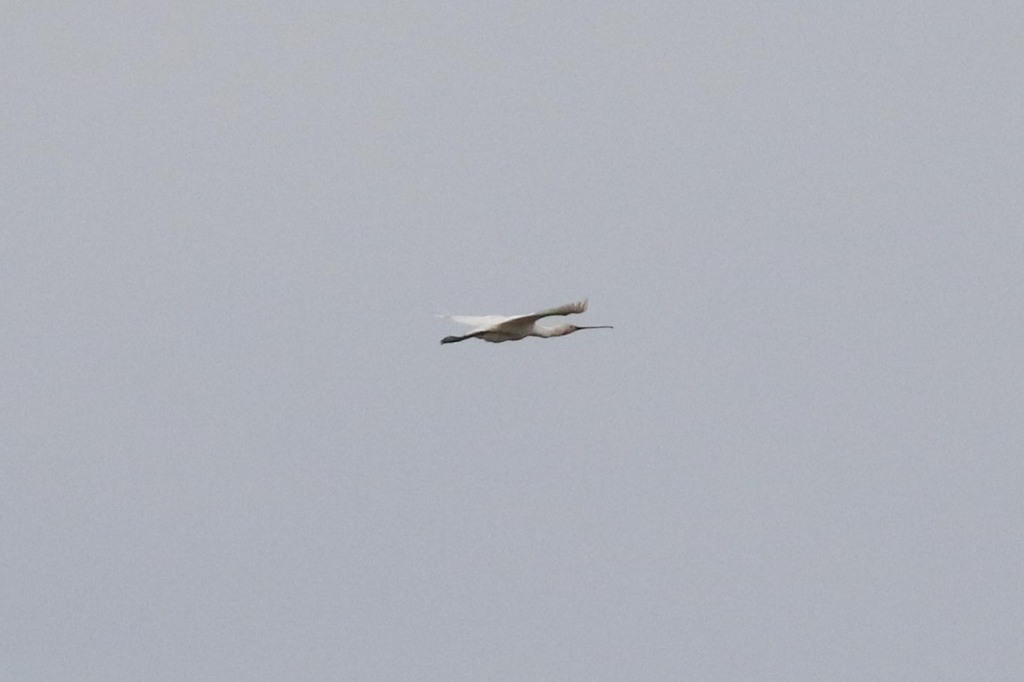
The bushes by the path were quiet and even round the whirligig, where there are lots of berries, we couldn’t find anything. We decided to just have a quick look along the path just the other side of the Whirligig then head back, and it was good we did. The bushes here were alive with warblers – Common Whitethroats and Lesser Whitethroat, and Blackcaps. They were hard to see at first, flitting around on the far side of the hedge. A Reed Bunting was more obliging, and perched up on top.
We eventually got good views of several warblers in the top of a large hawthorn. Another bird appeared with them – a Redstart! It only stayed a second, but we all got a look at it before it flicked off back into the bushes.
The flock appeared to be heading along the hedge line so we continued round for a better look. We caught the back end of a flock tits heading inland along the track, which presumably took some of the other birds with it. There were several Common Whitethroats still lingering in the bushes. Someone had a brief flash of what might have been a Pied Flycatcher. Then we had a brief glimpse of what might have been the Redstart again, as it flicked across. But despite waiting a few minutes, nothing came out again.
We walked back round and the bushes where everything had been were now quiet. So we decided to walk back. The Whimbrel was on the saltmarsh just below the path, but flew back as we approached. It landed on the edge of a small pool, near to a roosting Curlew and through the scope we could see the Whimbrel feeding just behind it, another great comparison.
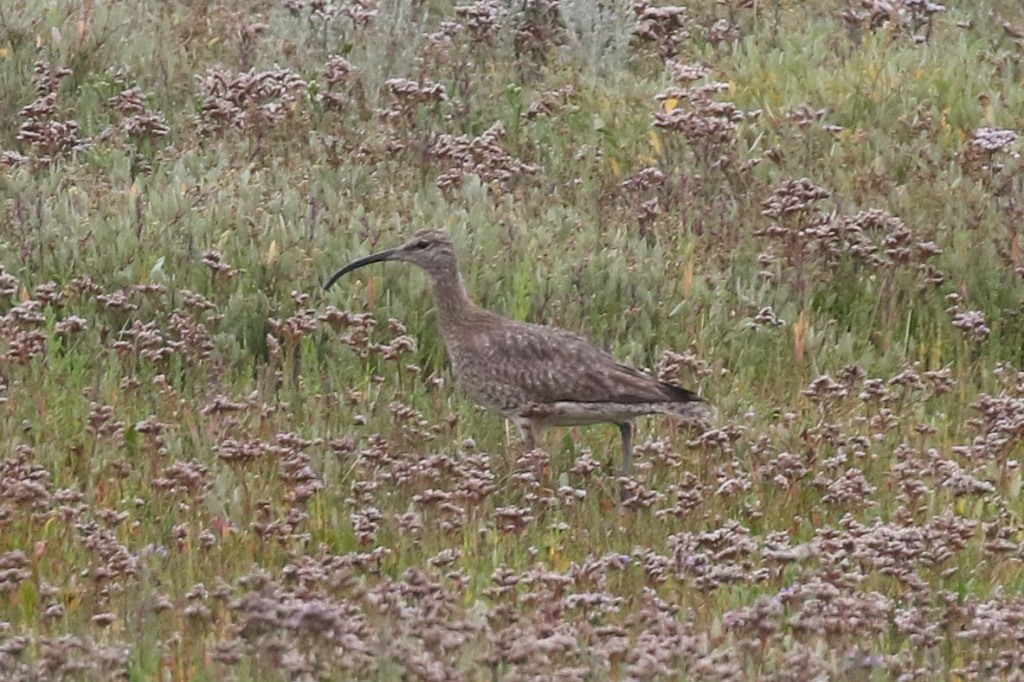
Given the Redstart hinted at the possibility of migrants freshly arrived, we decided to have a quick look in Campsite Wood. It was disappointingly quiet – plenty of Woodpigeons, as usual, we heard a couple of Great Tits, but nothing else. The wind seemed to have picked up a little compared to earlier, and the wood is very exposed to a north wind. There were also still quite a few people in the wood despite the campsite being much quieter now.
Out the far side of the wood, we scanned and picked up a couple of Common Buzzards hanging in the air in the distance. A Kestrel flew in off the saltmarsh and hovered right above us. Two Speckled Wood butterflies were feeding on overripe blackberries deep in the brambles. We walked back along the front, passing a Little Egret feeding in the channel next to us.
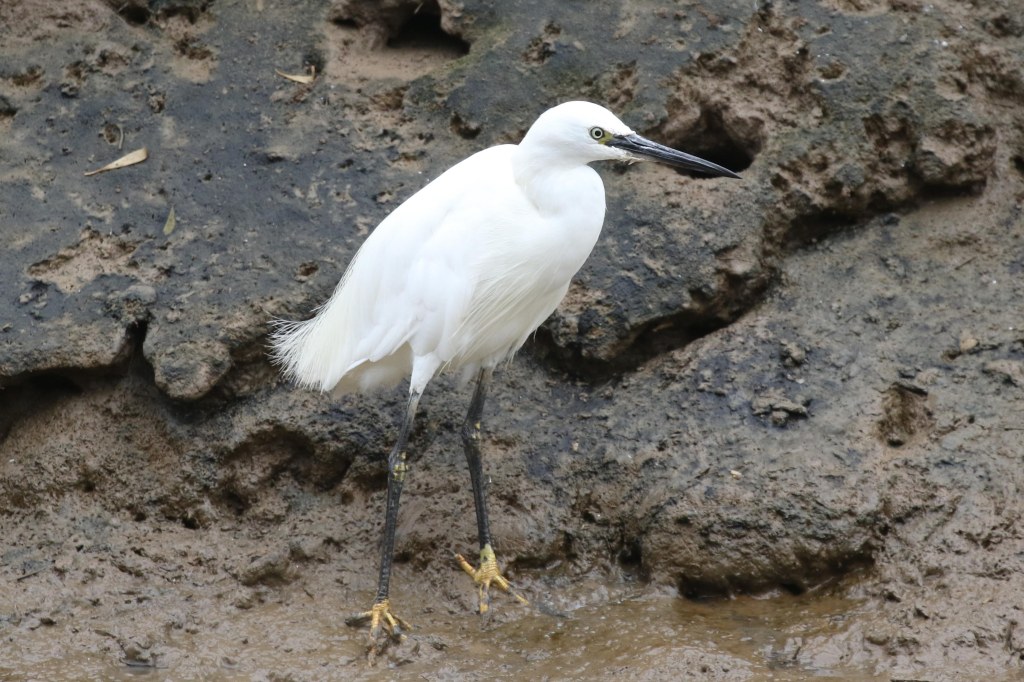
When we got back to the minibus, we stopped for a coffee break. Checking the news, there didn’t seem to be much new turning up elsewhere, so we decided to head over to Titchwell for the afternoon, to try to add some waders to the list. It was already midday by the time we got there, so we stopped for an early lunch. A Common Swift passed back and forth over the sallows from the picnic area – the first we have seen for several weeks now, as most have already left us for the winter.
After lunch, we made our way out onto the reserve. There were lots of House Martins and a few Swallows hawking over the reedbed, but we couldn’t see the Swift now. A Marsh Harrier was quartering over the Thornham grazing marsh but there was no sign now of the Whinchat which had been reported here earlier. The reedbed pool held just one Tufted Duck, but we found two Common Pochard diving in the channel just beyond. A Cetti’s Warbler sang a couple of times very half-heartedly in reeds.
The works are still ongoing on the Freshmarsh, with the diggers working out on the edge of the reeds today, but the waders didn’t seem to care. It anything, the low water levels and freshly churned up mud are proving more attractive for them this year. We could see lots of Black-tailed Godwit and Ruff scattered around the scrapes, and plenty of Avocets still too, although numbers are now dropping.
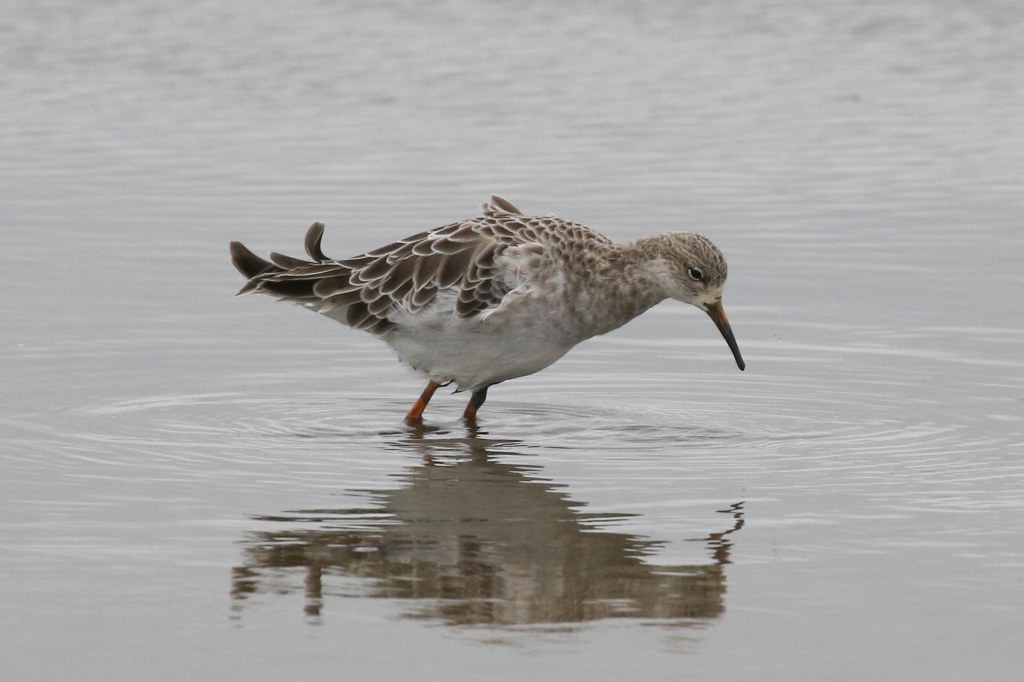
A couple of Common Snipe flew off before we could get the scope on them, but a group of Turnstone bathing and preening on the edge of the new bund lingered a little longer, before they flew off too, back towards the beach. A single Knot was roosting behind a large lump of mud churned up by the diggers and we picked up a couple of Ringed Plovers feeding on the drier mud.
The Dunlin were obviously favouring the area at the back, where the diggers are working. When a group were disturbed and flew round, we could see a flash of a white rump with them. They landed our side of the new N/S bund, and a quick scan confirmed a juvenile Curlew Sandpiper was in with them. We got it in the scope, as it stopped to bathe. There were a couple of Little Stints in the flock too, but the whole flock quickly drifted back and disappeared behind the new bank again.
The variety and number of ducks is steadily increasing now, as birds return for the winter. We could see lots of Teal out here today, along with a few Gadwall and Shoveler, and a couple of Pintail asleep.
We decided to walk round to Parrinder to see if we could get a better look at the small waders. We didn’t go into the hide, but scanned from the balcony beyond, where a bit of elevation meant we could see more of the mud over the fence round Avocet Island. We could see Curlew Sandpiper again from here. It was over on the mud in front of the diggers, and didn’t seem at all concerned. We counted at least five Little Stints too, all fresh juveniles, from here. Eventually a couple came in a bit closer and fed for a while where we could get a good look at them through the scopes. A Common Sandpiper was working its way back along the edge of the new muddy channel by the bund.

There were lots of Linnets, Meadow Pipits and a few Pied Wagtails in front of the hide too, taking advantage of the works to feed on the dried out bits of the new scrapes.
We decided to head out to the Tidal Pools, as it was approaching high tide and we figured there should be some birds roosting on there now. A lone Redshank was on the near channel of Volunteer Marsh as we passed, and a few more plus a handful of Black-tailed Godwits and a couple of Curlew on the muddy channel at the far end.
There were lots of waders roosting on the Tidal Pools – most impressive, there were at least a thousand Knot. A large gathering of Oystercatchers were on the grassy island too. Scanning the edges, we found a couple of Grey Plover, including one very smart one which dropped in briefly. Several Turnstone included two very smart birds still in breeding plumage.
Two Pintail were upending in the water, perhaps the same two as we had seen earlier on the Freshmarsh. Both were drakes in eclipse plumage, so not looking their best.
Having come this far, we decided to continue on to the beach. Several little groups of Sanderling were running in and out of the waves along the shore. There were more waders, including a number of Bar-tailed Godwits further up along the beach, towards Thornham Point. A few gulls and Turnstones were feeding on shellfish which had been washed up on beach. When something flushed all the Knot from the Tidal Pools, we turned to see them fly out over the beach. Half landed out on the shore, but the others flew round and then went back to where they had come from.
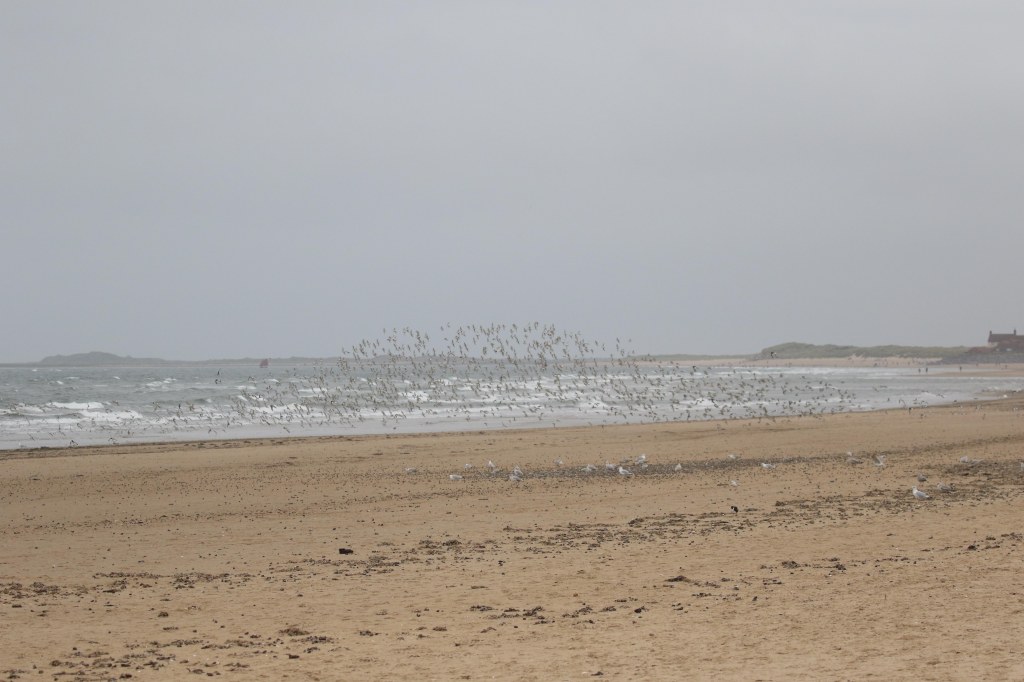
There was not much out to sea now – the seawatching had dried up steadily as the wind had dropped further today – just one Sandwich Tern fishing offshore, and a few distant Cormorants coming and going from Scolt Head.
As we turned to walk back, all the Knot went up again. We looked up to see a young Peregrine flying over. It headed out over the beach.
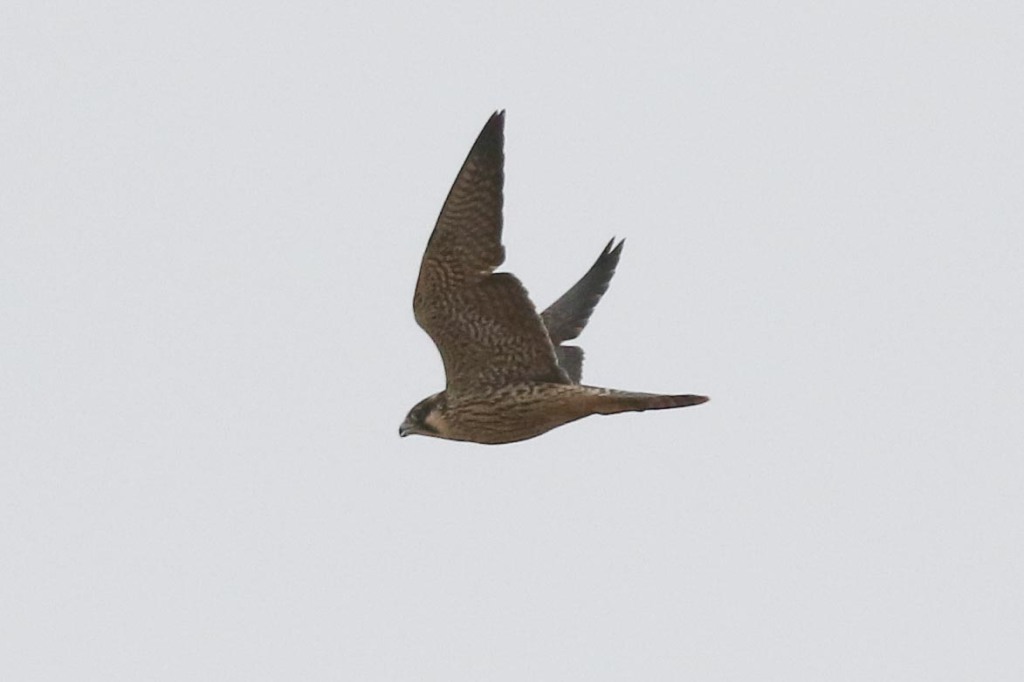
That was a nice bird to end the two days – we made our way back to the minibus and headed back inland to the accommodation.
















